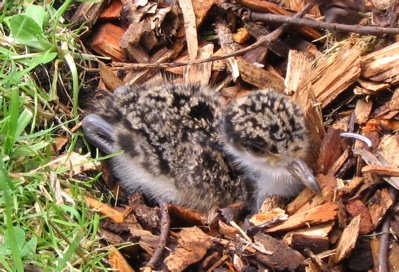Breeding Distraction 1: Masked Lapwing
 While visiting the Hobart Botanical Gardens, Tasmania in Dec 2005, Teo Lee Wei and family “came across a pair of birds about the size of crows. They were running and flying very low, calling in distress and visibly stressed. Their antics seemed like some distracting ploy. Then we noticed five little chicks running helter-skelter in all directions but generally towards the parent birds.
While visiting the Hobart Botanical Gardens, Tasmania in Dec 2005, Teo Lee Wei and family “came across a pair of birds about the size of crows. They were running and flying very low, calling in distress and visibly stressed. Their antics seemed like some distracting ploy. Then we noticed five little chicks running helter-skelter in all directions but generally towards the parent birds.“We managed to get near two little chicks and when we were within a metre of them they promptly sat down. Managed to snap the picture of one that was very well camouflaged. All the while the parent birds kept up their high-energy and high-decibel antics. When we moved a little away from the chicks, the two got up and ran towards the parents.
 “Throughout the two hours we were there the same thing happened without a break.
“Throughout the two hours we were there the same thing happened without a break.“When we returned the gardens the following day, we witnessed the same thing. We wondered why the parents chose a well-walked area to raise their brood when there were so many quiet corners in the huge garden grounds.
“When we visited Grindewald (Swiss Village) near Launceston we saw many of these birds near the roadside. The coach driver said they are Australian road runners. We did not see any little chicks running around or their antics.
“The episode reminds me of my own antics while raising my son. Humans share a lot of genes with birds I understand. Maybe I'm bird-brain wired and so can empathise with them.”
Note: The bird is actually a Masked Lapwing (Vanellus miles). They are very noisy, making a loud ‘kekekekekek’ call. The nest is a scrape in the ground, lined with grass and small twigs or unlined. The nestlings quit the nest within a few hours of hatching, to be led away by the parents to shelter. They are defended vigorously, the parent birds diving at intruders with a daunting screaming chatter.
Text and images by Lee Wei.



0 Comments:
Post a Comment
<< Home